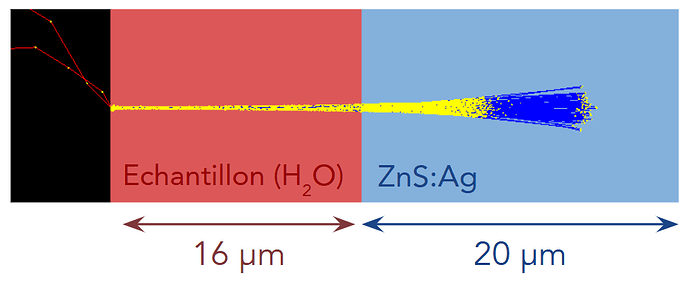Hello,
I am simulating the trajectory and energy deposition of alpha particles in a scintillator material, the shape of the trajectories and energy deposition are not how I expect them to be and I can’t manage to correct it. Especially, my simulation doesn’t render the bragg peak of the energy deposition properly.
To give more detailed information :
- I am shooting 5.5 MeV alphas in a ZnS material of density 4.09.
- This is my PhysicsList :
CustomPhysicsList::CustomPhysicsList() {}
CustomPhysicsList::~CustomPhysicsList() {}
void CustomPhysicsList::ConstructProcess()
{
QGSP_BIC::ConstructProcess();
RegisterPhysics(new G4StepLimiterPhysics());
// Default physics
RegisterPhysics(new G4DecayPhysics());
// Radioactive decay
RegisterPhysics(new G4RadioactiveDecayPhysics());
// EM physics
RegisterPhysics(new G4EmStandardPhysics_option4());
//RegisterPhysics(new G4EmLivermorePhysics());
RegisterPhysics( new G4HadronPhysicsQGSP_BIC_HP());
RegisterPhysics( new G4EmExtraPhysics());
RegisterPhysics( new G4HadronElasticPhysics());
RegisterPhysics( new G4StoppingPhysics());
RegisterPhysics( new G4IonBinaryCascadePhysics());
RegisterPhysics( new G4NeutronTrackingCut());
// Optical physics
G4OpAbsorption* absorption = new G4OpAbsorption();
G4OpBoundaryProcess* boundary = new G4OpBoundaryProcess();
G4Scintillation* scint = new G4Scintillation(“Scintillation”);
scint->SetTrackSecondariesFirst(true);
// Add processes to particles when applicable
auto theParticleIterator = GetParticleIterator();
theParticleIterator->reset();
while( (*theParticleIterator)() )
{
G4ParticleDefinition* particle = theParticleIterator->value();
G4ProcessManager* pmanager = particle->GetProcessManager();
G4String particleName = particle->GetParticleName();
if (scint->IsApplicable(*particle))
{
pmanager->AddProcess(scint);
pmanager->SetProcessOrderingToLast(scint, idxAtRest);
pmanager->SetProcessOrderingToLast(scint, idxPostStep);
}
if (particleName == "opticalphoton")
{
pmanager->AddDiscreteProcess(absorption);
pmanager->AddDiscreteProcess(boundary);
}
}
}
-
This is what my trajectories look like (in red : water, in blue : ZnS) : a lot of interactions troughout the track and a big step with “huge” energy deposition (1.5-2 MeV) at the end, whereas I expect to see an increasing number of interactions at the end of the track and higher energy deposition.
-
I then compare the energy deposition from Geant4 to SRIM simulations : the LET seems to be overestimated at the beginning of the track and then underestimated at the end. For instance the energy deposited at the end of the final big step is lower than it should be and the bragg peak isn’t rendered properly.
Any idea where the problem may come from ? I am relatevely new to Geant4 I am not entirely sure if my physics list is implemented properly and if I use the correct processes for my simulation.
Thanks in advance.
Geant4 Version: 4.11.03

